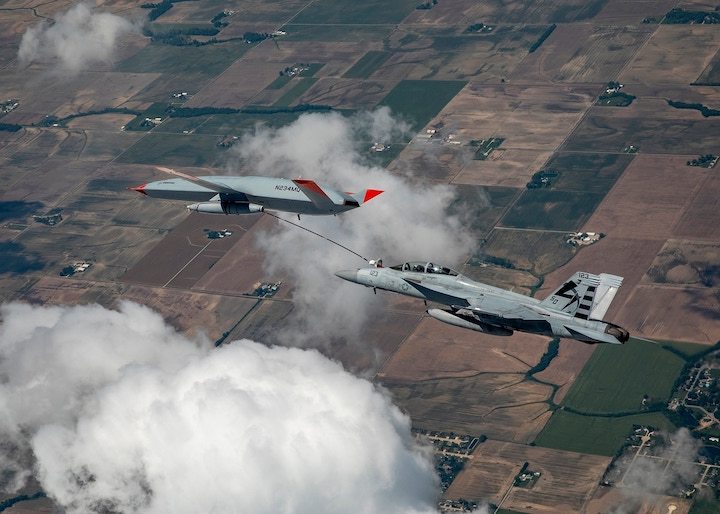WASHINGTON — Boeing conducted its first manned-unmanned teaming test of the MQ-25A Stingray paired with U.S. Navy aircraft, demonstrating the unmanned tanker can take commands from pilots midair and adjust as the mission changes.
The MQ-25 was designed to primarily communicate with a ground-based air vehicle operator, or AVO — likely located on an aircraft carrier — but that could change as the drone’s mission set and concept of operations evolve.
The drone flies autonomously, but it’s nearly always in contact with the an AVO and flies a mission plan it’s given ahead of time, Boeing’s MQ-25 advanced design leader BD Gaddis told reporters Aug. 3 at the Navy League’s Sea Air Space conference.
But when the UAV sees its first action in combat, “what happens when those communication links are either degraded, denied or prohibited?” Gaddis questioned. “That’s why manned-unmanned teaming is essential to MQ-25, because we can’t be talking to the AVO all the time.”
Gaddis said communications between the MQ-25 and the aircraft carrier could be cut off if an adversary jams or otherwise disrupts the network, or if the ship’s crew halts its communications as a means of hiding from an adversary.
“We’re building an airplane that goes to war, so we want that airplane to be robust and capable when it goes to war. We already know there will be eras and times that the carrier will decide it wants to shut its radios down and move, and our airplane can’t just say: ‘I have to go home.’ That’s not OK. We know that; the Navy’s told us that; we’re working that,” Dave Bujold, Boeing’s MQ-25 program director, said at the event.
During the demonstration, which took place in a virtual environment, the MQ-25 was given a mission plan and launched from the carrier. Then, once airborne, a Boeing F/A-18E/F Super Hornet and a Northrop Grumman E-2D Advanced Hawkeye sent messages via the Link 16 tactical data link network to the drone, asking it to deviate from the mission plan and refuel them in a different location with a different quantity of fuel, among other alternate conditions.
Gaddis explained one vignette: when a Super Hornet needs to refuel but is in a hurry to fly to a target. The fighter doesn’t want to radio back to the carrier and announce that it’s heading to a target, ruining the element of surprise. So the jet messages the Stingray to leave its orbit around the carrier and meet the jet in a new location en route to its target.
The challenge in this scenario is that the MQ-25 must first recognize it’s receiving orders that override its preplanned mission. Then it must understand that a manned plane in the air is giving it orders, not the carrier-based operator. And then it must translate the order into autonomous behaviors and act accordingly.

